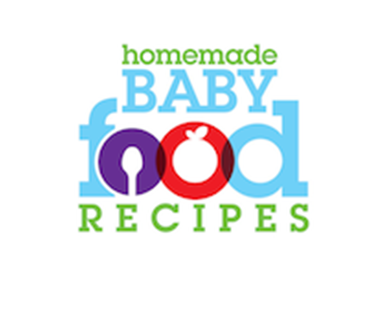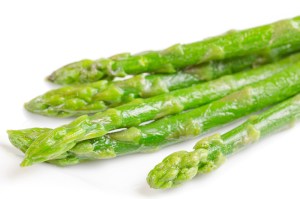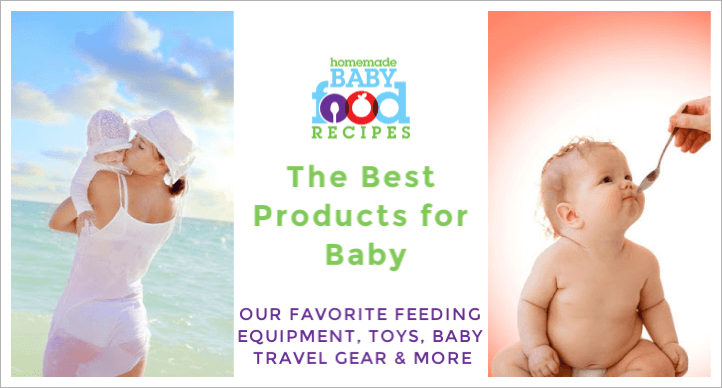Asparagus Baby Food Recipes
Updated Sept 21st, 2023
With these asparagus baby food recipes you're providing your little one with an amazing array of nutrients and one of the best vegetable sources of folate around!
NOTE: Please consult your doctor before you introduce these recipes, or any new foods, to your baby.
The information given here is for guidance only and does not replace professional medical advice.
When can my baby eat asparagus?
Asparagus is not considered to be a common allergen, although – as with all new foods - it's best to use the four day rule as you introduce it.
Asparagus contains raffinose, the same substance that’s in beans and which tends to cause gas!
However, asparagus contains less raffinose than beans. That means it may cause discomfort in some babies and not others.
Luckily for us, we’ve never noticed a problem with gassiness in our babies after giving them asparagus!
Nevertheless, it’s not a good idea to introduce asparagus as a very first food.
In fact, we recommend avoiding it altogether before 6 months of age (please see this page for more information about introducing solids before 6 months).
You can try offering asparagus after your baby is enjoying other fruits and vegetables, from 6 months of age.
Delay its introduction until later in baby’s first year if he’s prone to upset tummies and gas (wind).
PLEASE NOTE:
Eating asparagus can cause your baby’s pee to smell strange and may even turn it green!
This is a perfectly harmless phenomenon that affects adults too, and is caused by the production of certain compounds as the asparagus is digested.
Asparagus baby food recipes – nutrition information
Often referred to as the ‘vegetable of kings’, asparagus is an ancient food, long revered for its wonderful flavour and perceived medicinal properties.
Very high in antioxidants, asparagus is also a particularly rich source of folate.
You’ll probably remember being urged to take folic acid supplements (the synthetic form of folate) during pregnancy, because it helps protect against birth defects.
But folate continues to be good for your baby as it promotes heart health and helps the body both produce and maintain new cells.
Asparagus also helps maintain a healthy gut.
This is because it contains inulin, a substance that it is not digested and moves to the large intestine, where it provides food for all the ‘good’ bacteria living there!
This helps the ‘good’ bacteria grow and flourish, promoting a healthy digestive system.
What’s more, asparagus – which offers protection against serious conditions like heart disease and cancer – also contains
- B vitamins
- vitamin C
- vitamin K
- vitamin A
- vitamin E
- calcium
- magnesium
- zinc
- protein
- fibre
- phosphorus
- iron
- potassium
Whew – who knew those delicious green stalks packed such a nutritious punch?
Buying and storing asparagus for use in your baby food recipes
There’s no getting away from the fact that asparagus tends to be horribly expensive!
Growing and harvesting asparagus is both time and labour intensive, hence the cost.
But when buying asparagus for your baby, remind yourself of this…
it’s still an awful lot cheaper than buying jars of pre-prepared baby food… and it’s MUCH healthier for your little one!
Look for bright green asparagus stems – the thinner, the better.
It’s also possible to buy white asparagus (which is white because it’s grown underground, so that its green chlorophyll does not develop).
However, white asparagus is not as nutritious as green.
If you’re very lucky, you might even come across purple asparagus.
This contains lots of anthocyanins, the anti-oxidants that give red and purple grapes their colour.
Purple asparagus spears are smaller than green or white ones and have a more robust flavour.
Whichever type you buy, ensure the stalks are nice and firm and the tips are closed.
When you get your asparagus home, wash it well (taking care to remove all the dirt from the woody stems).
Then wrap a damp paper towel around the stems – or stand them in a glass in a couple of inches of water – and store them in the fridge for up to two days.
Push them right to the back of the shelf. That's because exposing them to light decreases their nutritional value.
Use frozen asparagus if you can’t get fresh, but cook it straight from the freezer without thawing it first.
Alternatively, use canned asparagus.
Look for a low sodium or salt free variety, but remember that canned asparagus is very mushy.
While it would be OK for purees and veggie combos, it certainly couldn’t be used as a finger food (as we suggest later in this article).
If you can only obtain fresh asparagus for a very limited part of the year, then just buy extra and freeze it.
To do this, blanch it in boiling water for 2 mins, then plunge it into a bowl of icy water to stop the cooking process.
You can then put it into zip-top bags and store them in the freezer.
For maximum nutrition, use them within one month (although they will keep for several months longer).
How to prepare and cook asparagus for your baby
Simply wash the spears as described above, then bend each one until it naturally snaps at the point where the woody stem ends and the tender stalk begins.
Don’t throw the woody ends away – we use ours to make stock, to which they add a lovely flavour.
You can also puree them up and mix with water as a soup base if they are not too tough.
We find that steaming asparagus is the best way to cook it.
The cooking time depends on the thickness of the spears.
Very thin ones take as few as 3 minutes, whereas it can take up to 8 minutes for thicker ones to become tender.
NOTE: Don’t cook asparagus in iron pots. The tannins in the asparagus react with the iron, turning the spears a funny colour!
You may also boil asparagus spears in a little water until crisp-tender, but be careful not to overcook them.
This will make them less nutritious - not to mention waterlogged and mushy!
An Asparagus Steamer is a handy tool to have because it cooks the spears upright.
This allows you to cook the stems more thoroughly while gently steaming the tips.
Asparagus baby food recipes and ideas
Asparagus is great served hot or cold.
If you want to serve it cold, plunge it into icy water right after cooking it to stop it getting mushy.
Keep it in the fridge until ready to serve.
Asparagus spears are easily held in little fists, making them a super finger food or ideal for baby led weaning.
Cut longer spears in half or your little one might have trouble getting the tips into his mouth.
Why not try…
- Tossing steamed asparagus spears in extra virgin olive oil and serving them just as they are, or with a little sprinkle of grated Parmesan cheese…mmm!
- Adding chopped asparagus to soups or stews around 5 minutes before the end of the cooking time.
- Making a simple asparagus puree by blending the cooked spears in a food processor until smooth.
Asparagus and Apple Puree (6 months+)
A sweet fruit and vegetable dish that always had our little ones clamouring for more!
1/2 sweet apple, cored and sliced*
4 asparagus spears
low sodium or homemade vegetable stock
*We prefer to leave the apple unpeeled. Please see this page for more information to help you decide whether or not to peel fruits and vegetables for your baby.
- Place the asparagus spears and sliced apple in a small saucepan and just cover with stock.
- Bring to a boil, then reduce the heat and simmer for around 5 minutes until the apple and asparagus are tender.
- Transfer to a food processor and puree until smooth, adding as much of the cooking liquid as you need to achieve the desired texture.
Variations: Once baby is enjoying meat, try adding chopped cooked chicken to the mixture!
Creamy Asparagus Dip (6 months+)
2 tbsp homemade yogurt cheese or cream cheese
1 tbsp natural yogurt
3 cooked asparagus spears, chopped well
- Beat together the cream cheese and yogurt, then fold in the cooked asparagus.
- Use as a dip, sandwich filling/spread, or a delightful topping for a baked potato.
Asparagus Scramble
Ideal for when baby is enjoying whole eggs (or make with the yolks only, reducing the amount of cream cheese by half).
2 eggs
2 tbsp cream cheese*
2 asparagus spears, cooked and chopped
*The whipped variety is best as it’s easier to stir in.
- Heat a little oil in a frying pan/skillet.
- Beat the eggs, then add them to the pan, stirring.
- As the mixture starts to set, stir in the cream cheese and the asparagus.
- Cook until done – we prefer to cook until lightly set if baby will be eating this from a spoon, or until firm if he’ll be eating it with his fingers.
Asparagus Funny Fingers
A simple finger food for older babies!
cooked asparagus spears
small, whole wheat flour tortillas
grated Cheddar cheese
- Take a tortilla, sprinkle with cheese, then place a cooked asparagus spear inside.
- Roll up.
- Place under a broiler/grill set to medium and cook, turning, until the cheese has melted.
- Serve when warm.
We hope your baby enjoys these nutritious and delicious asparagus baby food recipes.
You may also like:
From our blog – Creamy Asparagus Soup


